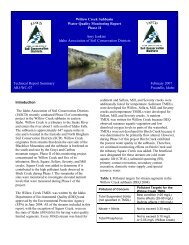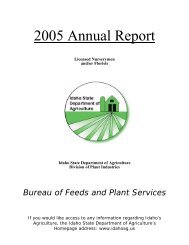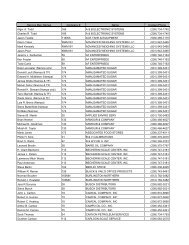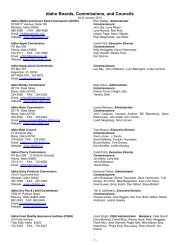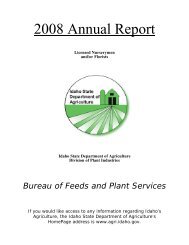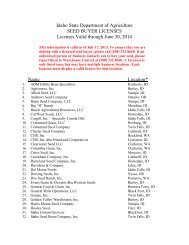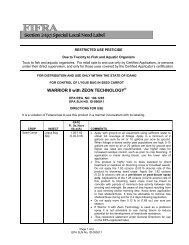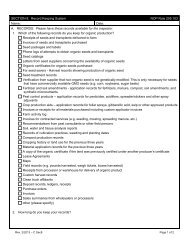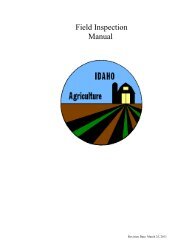2008 Statewide Strategic Plan for Eurasian Watermilfoil in Idaho
2008 Statewide Strategic Plan for Eurasian Watermilfoil in Idaho
2008 Statewide Strategic Plan for Eurasian Watermilfoil in Idaho
You also want an ePaper? Increase the reach of your titles
YUMPU automatically turns print PDFs into web optimized ePapers that Google loves.
Option How it Works Pros Cons Suitable Areas <strong>for</strong> use <strong>in</strong> <strong>Idaho</strong><br />
4.Physical<br />
Native<br />
vegetation<br />
<strong>Plan</strong>t<strong>in</strong>g a diverse native<br />
plant community to<br />
compete with EWM<br />
Native plants provide food and<br />
habitat <strong>for</strong> native fauna<br />
Initial transplant<strong>in</strong>g slow<br />
and labor <strong>in</strong>tensive<br />
Relatively small areas. None are<br />
eligible <strong>for</strong> state fund<strong>in</strong>g.<br />
Supplements other techniques<br />
EWM may outcompete<br />
plant<strong>in</strong>gs<br />
Largely experimental: few<br />
well-documented cases<br />
and it is questionable if<br />
native plants significantly<br />
reduce the <strong>in</strong>vasive<br />
potential of <strong>Eurasian</strong><br />
watermilfoil<br />
Effectiveness questionable<br />
<strong>Plan</strong>t<strong>in</strong>gs from non-local<br />
sources may genetically<br />
swamp local populations<br />
5. Manual and Mechanical control <strong>Plan</strong>ts reduced by<br />
mechanical means<br />
Flexible Control<br />
Must be repeated, often<br />
more than once per season<br />
Can balance habitat and<br />
recreational needs<br />
Can suspend sediments,<br />
<strong>in</strong>crease turbidity and<br />
nutrient release<br />
Hand pull<strong>in</strong>g<br />
SCUBA divers and<br />
snorkelers remove plants<br />
by hand or plants are<br />
removed by a rake<br />
Little or no damage done to<br />
native plant species<br />
Very labor <strong>in</strong>tensive<br />
Shallow, small area. Sensitive areas<br />
Works best <strong>in</strong> soft<br />
sediments<br />
Can be effective, particularly <strong>in</strong><br />
early phases of <strong>in</strong>festation<br />
Roots, runners and<br />
fragments will start new<br />
plants, so care must be<br />
taken to ensure complete<br />
removal<br />
May be suitable <strong>in</strong> areas where other<br />
methods are not effective or practical<br />
Can be done by shorel<strong>in</strong>e<br />
property owners<br />
Small scale control only<br />
Highly selective Sediment disturbance<br />
Harvest<strong>in</strong>g<br />
<strong>Plan</strong>ts are "mowed" at<br />
depths of 2-5 feet,<br />
collected with a conveyor,<br />
off-loaded onto shore<br />
Harvested lanes through dense<br />
beds can <strong>in</strong>crease growth and<br />
survival of some fish<br />
Not selective – removes<br />
non-target plants and<br />
animals<br />
Larger lakes (100+ acres), rivers with<br />
widespread, well-established EWM.<br />
Requires mach<strong>in</strong>ery launch sites and<br />
disposal off-load<strong>in</strong>g sites<br />
77



